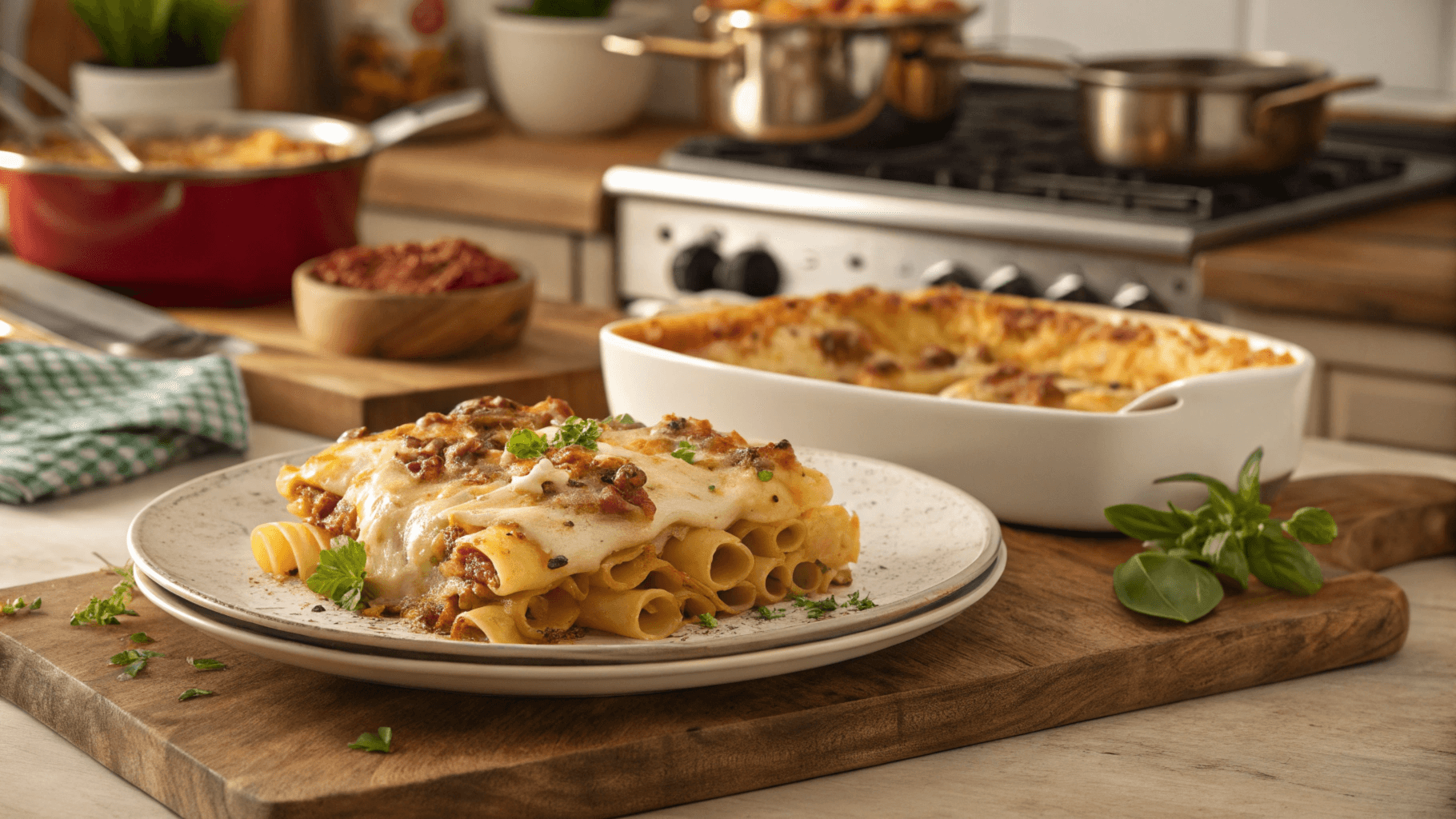Ah, gigli pasta! It’s not just another noodle on your plate; it’s a true celebration of Italian culinary artistry. Shaped like a delicate bellflower with ruffled edges, this unique pasta holds sauce in the most delightful way, making every bite a flavor explosion. Whether you’re a home cook or a pasta aficionado, this article will walk you through everything you need to know about gigli pasta: its origins, how it’s made, and the best ways to enjoy it. Ready to dive in? Let’s get started!
What is Gigli Pasta?
Defining Gigli Pasta
Gigli pasta—often called campanelle pasta—isn’t just pasta; it’s art on your plate. Its whimsical, flower-like shape with fluted edges sets it apart from other pasta varieties. Imagine a tiny bell or a delicate lily, each piece designed to hold onto sauces like creamy Alfredo or zesty marinara, making every bite as delicious as the last. But beyond its good looks, gigli pasta offers a unique textural experience that’ll keep you coming back for more.
The Origins of Gigli Pasta
Hailing from the lush landscapes of Tuscany, This pasta has a rich history tied to the region’s heritage. The word “gigli” means lily in Italian, and it’s no coincidence that the lily is the national emblem of Florence. This pasta’s name and shape honor that deep cultural connection. It’s no wonder gigli pasta is often referred to as gigli toscani, highlighting its Tuscan roots.
Popularity and Global Reach
While gigli pasta started as a regional treasure, its unique appeal has made it a favorite worldwide. From artisan Italian markets to grocery store shelves, its popularity continues to grow. Whether you’re in a quaint Tuscan trattoria or your kitchen at home, gigli pasta brings a touch of elegance and authenticity to every dish.
For ideas on enhancing your dishes, try pairing it with a flavorful garlic butter seasoning that complements its unique shape.
How Gigli Pasta is Made
Traditional vs. Mass-Produced Methods
When it comes to making this pasta, the process varies depending on whether it’s handcrafted or mass-produced. Traditional methods involve a simple yet precise dough made from semolina flour, eggs, and water. Artisans carefully shape each piece into its signature bellflower form, ensuring every pasta retains its charm and functionality. On the other hand, mass-produced gigli pasta uses advanced machinery to create consistent shapes at scale. These machines extrude the dough through specialized nozzles, while sharp blades cut it to the desired length.
Role of Specialized Equipment
The magic behind gigli pasta’s intricate shape lies in the equipment. A unique die, designed specifically for gigli, molds the dough into the iconic fluted edges and hollow center. These features aren’t just for looks—they make the pasta a sauce magnet, ideal for creamy and runny recipes alike. In artisanal kitchens, chefs rely on ruffled cutters and their hands to achieve similar results, blending skill with tradition.
Importance of Drying Techniques
Drying the pasta is a critical step that ensures its longevity and quality. Freshly shaped pasta contains about 30% moisture, which needs to drop to 12% for proper storage. Manufacturers use hot air to pre-dry the pasta, reducing moisture quickly while maintaining structural integrity. Afterward, cold air stabilizes the pasta, preventing cracks and ensuring even texture. These methods make dried gigli pasta a pantry staple, ready for any meal you dream up.
Cooking with Gigli Pasta
Basic Cooking Instructions
Cooking this pasta is surprisingly simple and perfect for all skill levels. Start by boiling a pot of salted water—a generous pinch of salt enhances the pasta’s natural flavor. Add the gigli pasta and let it cook until al dente, which takes about 8-10 minutes for dried pasta or 3-4 minutes for freshly made. Don’t forget to stir occasionally to prevent sticking. Once cooked, drain the pasta and immediately toss it with your sauce of choice for optimal flavor absorption.
For a delicious pairing, consider serving it alongside a hearty dish from this collection of beef heart recipes to add depth and protein to your meal.
Creative Recipes with Gigli Pasta
This versatile pasta shines in various dishes. Replace macaroni with this pasta in a gooey mac and cheese for a gourmet twist, or bake it into a hearty casserole layered with meat, veggies, and béchamel sauce. Looking for something lighter? Use this pasta as the base for a summer pasta salad, combining it with fresh tomatoes, basil, mozzarella, and a drizzle of olive oil.
Pairing Gigli Pasta with Sauces
Thanks to its unique shape, this pasta pairs beautifully with sauces. The fluted edges catch every drop of creamy Alfredo or tangy tomato sauce, while the hollow center holds the perfect amount of liquid for a balanced bite. Whether you’re craving a classic marinara or an inventive pesto-cream blend, gigli pasta ensures the flavors come together harmoniously. For an elevated dish, add sautéed mushrooms or pancetta to your sauce and let the pasta’s texture do the rest.
Making Gigli Pasta at Home
Crafting Dough for Gigli Pasta
Making this pasta at home is an adventure worth taking. Begin with a simple dough recipe—semolina flour, eggs, and a pinch of salt. Mix the ingredients until they form a firm dough, kneading it until it’s smooth and elastic. For best results, let the dough rest for 30 minutes. This allows the gluten to relax, making it easier to roll out and shape. With just a few pantry staples, you can recreate the magic of this pasta right in your kitchen.
For dessert lovers, finish your meal on a sweet note with a Greek-inspired treat from this selection of Greek desserts, complementing the rich flavors of gigli pasta dishes.
Shaping Techniques
The charm of this pasta lies in its intricate shape, but don’t let that intimidate you. Start by rolling the dough into thin sheets using a pasta machine or rolling pin. Use a fluted cutter to create rectangular pieces, then curl each rectangle into a cone shape. Gently press the edges to form the ruffled look that defines gigli pasta. Practice makes perfect, so don’t worry if your first few attempts look more like abstract art than pasta!
Challenges and Solutions
Shaping gigli pasta can be tricky, but a few hacks can ease the process. If the dough is too sticky, lightly dust it with flour. Struggling to form the bellflower shape? Try using small molds or even a pastry tip as a guide. And remember: imperfections add character! Homemade gigli pasta doesn’t have to look store-bought; its rustic appeal is part of its charm.
Substitutes for Gigli Pasta
Alternative Pasta Shapes
If you’re unable to find this pasta, don’t fret—there are plenty of substitutes to keep your recipe on track. Bow-tie pasta, also known as farfalle, is a delightful alternative with its similar ability to hold sauces. Conchiglie, or shell pasta, is another excellent choice, offering a comparable texture and sauce-catching quality. For something unique, try radiatore, a pasta shape reminiscent of tiny radiators that grips onto sauces effortlessly.
Choosing the Right Substitute
When choosing a substitute, consider the type of dish you’re preparing. For creamy sauces, opt for shell-shaped pasta like conchiglie. If your recipe involves baked dishes or casseroles, farfalle works wonderfully, thanks to its sturdy structure. Ultimately, the best substitute is one that complements the flavors and textures of your dish while ensuring the sauce clings to the pasta.
For more delicious pasta recipes and cooking ideas, check out Marry Me Chicken Pasta, a romantic and creamy dish that pairs beautifully with any pasta type.
FAQs
What Makes Gigli Pasta Unique?
The beauty of this pasta lies in its design. Its ruffled edges and hollow center make it perfect for holding onto sauces, ensuring every bite is packed with flavor. Its bellflower shape isn’t just visually appealing—it also adds texture and versatility to dishes, making it a standout choice among pasta lovers.
What Dishes Use Gigli Pasta Best?
This pasta shines in creamy and tomato-based recipes, where its unique shape can soak up every drop of sauce. It’s also ideal for baked dishes like casseroles, where its smaller size and fluted design create a hearty, satisfying meal. For something different, use gigli pasta in a cold pasta salad for a refreshing twist.
Can You Freeze Gigli Pasta?
Yes! You can freeze both fresh and cooked gigli pasta. For fresh pasta, lay the pieces flat on a baking sheet to freeze, then transfer them to a freezer bag. Cooked pasta can also be frozen with sauce, making it an easy meal option when you’re short on time.
Final Thoughts and Culinary Inspiration
Celebrating Gigli Pasta
Few pasta shapes are as charming and versatile as gigli pasta. Its ability to elevate even the simplest dish into a culinary masterpiece makes it a favorite among home cooks and chefs alike. Whether you’re recreating a Tuscan classic or experimenting with new recipes, gigli pasta brings both elegance and functionality to your plate. Its bellflower shape is more than just a pretty detail—it’s a tool for flavor, ensuring every bite is perfectly balanced.
Experimenting in Your Kitchen
The beauty of this pasta lies in its adaptability. Don’t be afraid to step outside traditional recipes! Try pairing it with unexpected sauces, like a rich butternut squash puree or a zesty lemon-olive oil dressing. For a fresh twist, toss it with seasonal vegetables and herbs. The possibilities are endless, and with gigli pasta as your base, your dishes are sure to impress.
Exploring More Pasta Ideas and Resources
More Delicious Pasta Recipes
If gigli pasta has piqued your interest, why not explore other unique pasta dishes? From hearty lasagnas to light and refreshing cold pasta salads, there’s a world of options waiting to be discovered. Many specialty blogs and recipe sites offer step-by-step guides to crafting delicious meals using gigli pasta or similar shapes.
Building Your Pasta Pantry
Stocking your kitchen with a variety of pasta shapes ensures you’ll always have the perfect match for any recipe. Alongside gigli pasta, consider keeping versatile options like penne, farfalle, or conchiglie on hand. Each offers unique benefits and can transform a dish with minimal effort. Whether you’re cooking for a weeknight dinner or a special occasion, having a diverse pantry makes meal prep a breeze.


7 thoughts on “Gigli Pasta: A Complete Guide to Cooking, Pairing, and Recipes”